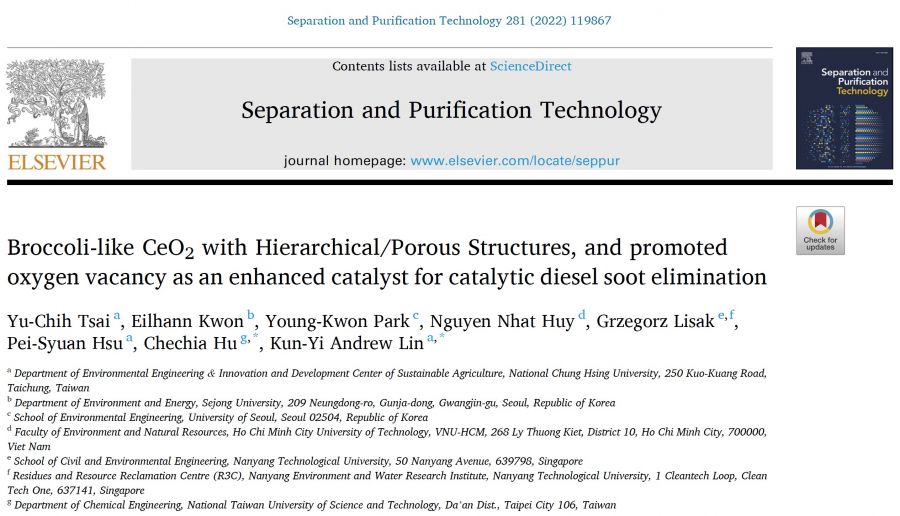循環農業:農業廢棄物高價值化【環境工程學系/林坤儀特聘教授】
| 論文篇名 | 英文:Broccoli-like CeO2 with Hierarchical/Porous Structures, and promoted oxygen vacancy as an enhanced catalyst for catalytic diesel soot elimination 中文:具有分層/多孔結構的西蘭花狀 CeO2,促進氧空位作為催化柴油煙灰消除的增強催化劑 |
| 期刊名稱 | SEPARATION AND PURIFICATION TECHNOLOGY |
| 發表年份,卷數,起迄頁數 | 2022, 281 ,119867 |
| 作者 | Tsai, Yu-Chih; Kwon, Eilhann; Park, Young-Kwon; Huy, Nguyen Nhat; Lisak, Grzegorz; Hsu, Pei-Syuan; Hu, Chechia; Lin, Kun-Yi Andrew(林坤儀)* |
| DOI | 10.1016/j.seppur.2021.119867 |
| 中文摘要 | 雖然 CeO2 是一種有前途的煙灰消除催化劑,但必須開發具有更高接觸面積的 CeO2,以及有效煙灰氧化的反應性,因為催化煙灰氧化主要由催化劑的結構和表面性質控制。在這項研究中,採用由 Ce 和均苯三酸 (TA) 組成的 Ce-Metal 有機框架 (MOF) 作為前體,因為 CeTA 表現出獨特的西蘭花狀層次結構,該結構轉化為具有由 CeO2 納米纖維組成的層次結構的 CeO2捆綁在一起,形成西蘭花狀的 CeO2 納米結構。更重要的是,這種花椰菜狀 CeO2 (BCL-CeO2) 中的 CeO2 納米纖維具有多孔結構和更多的氧空位,使 BCL-CeO2 成為一種有前途的煙塵氧化催化劑。因此,對於菸灰氧化,BCL-CeO2 顯示出比商業 CeO2 納米顆粒 (com-CeO2) 高得多的催化活性,並且點火溫度 (Tig) 顯著降低。更重要的是,雖然 com-CeO2 的煙灰氧化會導致 CO 與 CO2 一起產生,但 BCL-CeO2 可以將煙灰完全轉化為 CO2。緊密接觸模式還使 BCL-CeO2 表現出 295 °C 的非常低的 Tig,而 NO 和 H2O 的存在也增強了 BCL-CeO2 的煙灰氧化以降低 Tig。還檢查了 NO 輔助煙塵氧化的機制,並通過 DRIFTS 進行驗證,以確定含氮中間體的存在和轉化。 BCL-CeO2 還可以在許多連續循環中回收,並保持其對煙灰氧化的高催化活性。這些結果表明,BCL-CeO2 是一種有前途且易於製備的用於菸灰氧化的分層 Ce 基催化劑。 |
| 英文摘要 | While CeO2 is a promising catalyst for soot elimination, it is essential to develop CeO2 with higher contact areas, and reactivity for effective soot oxidation as catalytic soot oxidation is dominantly controlled by structures, and surficial properties of catalysts. In this study, a Ce-Metal organic frameworks (MOFs) consisting of Ce and trimesic acid (TA) is employed as the precursor as CeTA exhibits a unique broccoli-like hierachitecture which is transformed into CeO2 with a hierarchical structure consisting of nanofibers of CeO2 bundled together, forming a broccoli-like CeO2 nanostructure. More importantly, these CeO2 nanofibers in this broccoli-like CeO2 (BCL-CeO2) possesses porous structures, and also more oxygen vacancies, enabling BCL-CeO2 to become a promising catalyst for soot oxidation. Thus, BCL-CeO2 shows a much higher catalytic activity than commercial CeO2 nanoparticle (com-CeO2) for soot oxidation with a significantly lower ignition temperature (Tig). More importantly, while soot oxidation by com-CeO2 leads to production of CO together with CO2, BCL-CeO2 can completely convert soot to CO2. The tight contact mode also enables BCL-CeO2 to exhibit a very low Tig of 295 °C, whereas the existence of NO and H2O also enhances the soot oxidation by BCL-CeO2 to reduce the Tig. The mechanism of NO-assisted soot oxidation is also examined, and validated by DRIFTS to identify the presence and transformation of nitrogen-containing intermediates. BCL-CeO2 is also recyclable over many consecutive cycles and maintained its high catalytic activity for soot oxidation. These results demonstrate that BCL-CeO2 is a promising and easily-prepared hierarchitectured Ce-based catalyst for soot oxidation. |
| 發表成果與本中心研究主題相關性 | 透過本研究可進一步建立開發本研究計算所需之觸媒材料,並釐清可適合應用之環境條件! |







